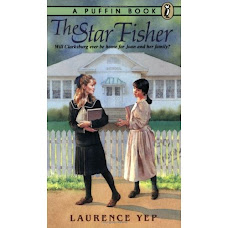BIBLIOGRAPHY
Say, Allen. 1999. Tea with Milk Houghton Mifflin/Walter Lorraine Books; 1st Ed edition ISBN-10: 0395904951 ISBN-13: 978-0395904954
SUMMARY
Tea with Milk, is the story of Say's parents Masako and Joseph. Masako was born near San Francisco and lived there until she graduated from high school. After graduating her family moved to Japan. Masako, or May for short, was considered a foreigner and didn't fit in. She had hopes of going to college but returned to high school in Japan to learn traditional things that she didn't learn in California. After her mother meets with a matchmaker and plans an arranged marriage, May decides to take things in her own hand. She goes to the city and finds a job running an elevator in a department store. When an English speaking family needs help communicating and getting directions, May is able to guide them. May is promoted to working with the customers that speak English. In her new position she meets a young businessman that was Japanese but raised by English foster parents. They become friends and discovered that they both grew up drinking tea with milk and sugar. When Joseph is transferred to another city, they decide to marry and start a new home together
CRITICAL REVIEW
Tea with Milk is a family story of a past generation. Say shares the cultural differences in the life his mother lived in California as a child before moving to Japan. In Japan she was expected to learn flower arranging and calligraphy. She was expected to wear a kimono and sit for long periods on the floor. It is interesting and shares several Japanese customs. When May is told she needs a husband she replies, "A husband! I'd rather have a turtle than a husband!" When she meets Joseph she changes her mind.
The illustrations by Allen Say are beautifully done. They resemble photographs from a family photo album. Older children and adults rather than the four to eight-year-old would appreciate the illustrations and story. The styles in the illustration are reminiscent of a time before Say was born.
REVIEW EXCERPTS
Kirkus Reviews
In describing how his parents met, Say continues to explore the ways that differing cultures can harmonize; raised near San Francisco and known as May everywhere except at home, where she is Masako, the child who will grow up to be Say's mother becomes a misfit when her family moves back to Japan. Rebelling against attempts to force her into the mold of a traditional Japanese woman, she leaves for Osaka, finds work as a department store translator, and meets Joseph, a Chinese businessman who not only speaks English, but prefers tea with milk and sugar, and persuades her that ``home isn't a place or a building that's ready-made or waiting for you, in America or anywhere else.'' Painted with characteristic control and restraint, Say's illustrations, largely portraits, begin with a sepia view of a sullen child in a kimono, gradually take on distinct, subdued color, and end with a formal shot of the smiling young couple in Western dress. A stately cousin to Ina R. Friedman's How My Parents Learned To Eat (1984), also illustrated by Say. (Picture book. 7-9) -- Copyright ©1999, Kirkus Associates, LP. All rights reserved.
Publishers Weekly
Say's masterfully executed watercolors tell as much of this story about a young woman's challenging transition from America to Japan as his eloquent, economical prose. Raised near San Francisco, Masako (her American friends called her May) is uprooted after high school when her parents return to their Japanese homeland. In addition to repeating high school to learn Japanese, she must learn the arts of a "proper Japanese lady" flower arranging, calligraphy and the tea ceremony, and is expected to marry well. Declaring "I'd rather have a turtle than a husband," the independent-minded Masako heads for the city of Osaka and gets a job in a department store. With his characteristic subtlety, Say sets off his cultural metaphor from the very start, contrasting the green tea Masako has for breakfast in her home, with the "tea with milk and sugar" she drinks at her friends' houses in America. Later, when she meets a young Japanese businessman who also prefers tea with milk and sugar to green tea, readers will know that she's met her match. Say reveals on the final page that the couple are his parents. Whether the subject is food ("no more pancakes or omelets, fried chicken or spaghetti" in Japan) or the deeper issues of ostracism (her fellow students call Masako "gaijin"Aforeigner) and gender expectations, Say provides gentle insights into human nature as well as East-West cultural differences. His exquisite, spare portraits convey emotions that lie close to the surface and flow easily from page to reader: with views of Masako's slumping posture and mask-like face as she dons her first kimono, or alone in the schoolyard, it's easy to sense her dejection. Through choice words and scrupulously choreographed paintings, Say's story communicates both the heart's yearning for individuality and freedom and how love and friendship can bridge cultural chasms. Ages 4-8.
Copyright 1999 Reed Business Information, Inc.
CONNECTIONS
Other books by Say
Say, Allen. 1993. GRANDFATHER'S JOURNEY. Houghton Mifflin/Walter Lorraine Books; ISBN-10: 0395570352 ISBN-13: 978-0395570357
Say, Allen. 1998. STRANGER IN THE MIRROR. Houghton Mifflin/Walter Lorraine Books; New Ed edition. ISBN-10: 039593883X ISBN-13: 978-0395938836
Say, Allen. 1989. THE BICYCLE MAN. Houghton Mifflin/Walter Lorraine Books; 1st Ed edition
ISBN-10: 0395506522 ISBN-13: 978-0395506523
Say, Allen. 2005. KAMISHIBAI MAN. Houghton Mifflin/Walter Lorraine Books.
ISBN-10: 0618479546 ISBN-13: 978-0618479542
*Work on a Genealogy project
Tuesday, July 24, 2007
Subscribe to:
Post Comments (Atom)







No comments:
Post a Comment